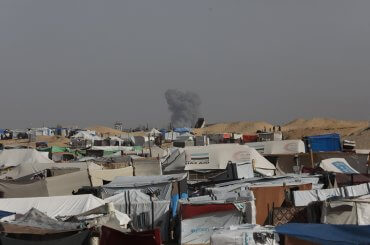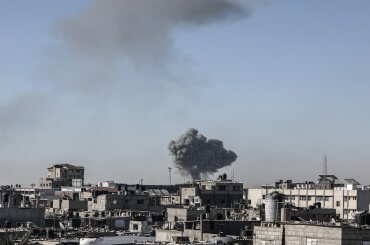
Two weeks ago the Globe ran an article touting Massachusetts’s partnership with Israel over water technology that left out the grossly-unfair distribution of water in Israel, on an ethnic basis. The reporter later acknowledged that she knew little about the politics of the matter. Now the newspaper has run two letters slamming the piece.
Once again, the readers are better than the reporters. First, “Discord and rancor grow in Israel’s verdant cropland.”
When I traveled from Israel’s desert landscape to verdant cropland, I shared the sense of amazement described in the Globe article “Water where there was none” (Page A1, Nov. 17). As a young Jew, like the article, I didn’t inquire about ecological and social consequences. Now as a water professional, I marvel at Israel’s innovative technologies but am troubled by their use.
For millennia, the Middle East offered lessons about how to thrive within water limits — lessons surely relevant in a planet whose hydrological cycles have now turned topsy-turvy. Thousands of years before Israel existed, Jews and Arabs sustainably managed the landscape.
Israel seems to have forgotten these techniques, now bulldozing climate-adapted olive groves for thirsty crops and settlements with swimming pools.
Israel’s desalination solution requires unsustainable amounts of energy. Israel’s higher per capita water use — three to six times that of Palestinians — adds fuel to conflict. We can’t survive water wars where nations and ethnic groups fight over this vital liquid and nature itself is left parched.
Water is a commons that we all must learn, or remember how, to share.
Daniel Moss
Jamaica Plain
And a letter from Marie Hoguet, “water innovation obscures a far messier, gloomier reality”:
RE “Water where there was none” (Page A1, Nov. 17): Your article’s silence about the extremely unequal allocation of water within the land controlled by Israel was astounding. Israel’s pursuit of greater water supplies may be a “battle with nature” and what one observer calls a “war against the desert,” but it has also been an ongoing and successful battle to exert complete control of the water in the ground, the Jordan River, and from the skies, and to severely restrict Palestinian access to these waters.
Had your reporter dug deeper into water in Israel, including the West Bank, whose aquifers are the source of much of Israel’s fresh water, and Gaza, she would have learned that it is the discriminatory access, distribution, and pricing of water, at least as much as the total amount of water, that is the fundamental issue. And if she had gone to the West Bank, she could have compared the attractive green landscaping, farms, and swimming pools of the settlements to the parched towns and fields of the Palestinians.
The World Bank, Amnesty International, and the human rights group B’Tselem have prepared analyses of Israel’s water policies in the West Bank and Gaza that make clear that water in Israel is as much a political issue as a technological one. Your article, with its charming photo of girls by the Sea of Galilee and invocations of idyllic forests, vineyards, and fruit orchards making the desert bloom, provides a distorted view of a much messier and less uplifting reality.
Marie Hoguet
Brookline


It’s great to see this finally break into public discussion. Ecology is real.
Great letters. Glad to see they were published, hope they were widely read.
Lebanon – given the Israeli voracity for others’ water resources, beware of their covetous eyes on the Litani River and be prepared for yet another attack in an attempt to control it.
http://www.ceia-sc.org/page55/page112/page118/page118.Israel.water.war.html
firstly I suggest for every one to make a feedback from the reports released by Amnesty, World Bank in 2009, B’etselm, World Health Organization to understand how Israel steals the Palestinian water for it’s own interests in the Illegal settlements in the west Bank< and inside Israel, and also Israel gives the Palestinians less quantities even less than what they agreed in Oslo Accords, the Palestinians buying their own water from Israel, Dr. Jad Isaac said "Israel sell to Palestinians the water beneath their foots", another note, is that Israel prevent the Palestinians from developing their water systems unless they have a permission from the Israeli authorities, what they call it (Civil Administration, which is rolled by an Israeli Army Officer). a final notice is that the Palestinians can make desert as a paradise just if they have the same opportunity like Israeli's.
The satellite images tell the tale. A direct side-by-side, green v. brown, simultaneous comparison.
http://i1012.photobucket.com/albums/af247/ritzl/IsraelSatelliteImage.jpg
That infographic should be amended to include a representative US city’s water consumption. Some known/lived comparison is needed to give people something to relate to. The US used roughly 4,000 l/day per capita, in 2005 (all uses, ±25% in other sources in a quick search). Ann Arbor, MI (college town, residential community) had a 2011 per capita water consumption of 115 gal/day (~400 lit/day).
For an “average” US person to live, water-wise, like a Palestinian we would have to cut our consumption by >90%. Only ~75% to live like the Israeli right next door.
Glad the Globe got pushback on this. Zero perspective in the original article.